Liquefied petroleum gas
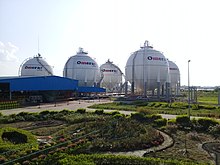

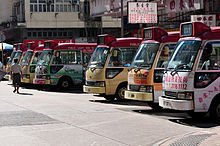

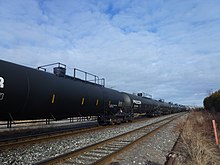
Liquefied petroleum gas,also referred to asliquid petroleum gas(LPGorLP gas), is afuel gaswhich contains aflammablemixture ofhydrocarbongases, specificallypropane,n-butaneandisobutane.It can sometimes contain somepropylene,butylene,andisobutene.[1][2][3]
LPG is used as afuel gasinheating appliances,cooking equipment, and vehicles. It is increasingly used as anaerosol propellant[4]and arefrigerant,[5]replacingchlorofluorocarbonsin an effort to reduce damage to theozone layer.When specifically used as a vehicle fuel, it is often referred to asautogasor even just asgas.
Varieties of LPG that are bought and sold include mixes that are mostly propane (C
3H
8), mostly butane (C
4H
10), and, most commonly, mixes including both propane and butane. In the northern hemisphere winter, the mixes contain more propane, while in summer, they contain more butane.[6][7]In theUnited States,mainly two grades of LPG are sold: commercial propane and HD-5. These specifications are published by the Gas Processors Association (GPA)[8]and the American Society of Testing and Materials.[9]Propane/butane blends are also listed in these specifications.
Propylene,butylenesand various other hydrocarbons are usually also present in small concentrations such asC2H6,CH4,andC3H8.HD-5 limits the amount of propylene that can be placed in LPG to 5% and is utilized as an autogas specification. A powerfulodorant,ethanethiol,is added so that leaks can be detected easily. The internationally recognized European Standard is EN 589. In the United States,tetrahydrothiophene(thiophane) oramyl mercaptanare also approved odorants,[10]although neither is currently being utilized.
LPG is prepared byrefiningpetroleumor "wet"natural gas,and is almost entirely derived fromfossil fuelsources, being manufactured during the refining of petroleum (crude oil), or extracted from petroleum or natural gas streams as they emerge from the ground. It was first produced in 1910 byWalter O. Snelling,and the first commercial products appeared in 1912. It currently provides about 3% of all energy consumed, and burns relatively cleanly with nosootand very littlesulfuremission. As it is a gas, it does not pose ground orwater pollutionhazards, but it can causeair pollution.LPG has a typical specificcalorific valueof 46.1 MJ/kg compared with 42.5 MJ/kg forfuel oiland 43.5 MJ/kg for premium gradepetrol(gasoline).[11]However, itsenergy densityper volume unit of 26 MJ/L is lower than either that of petrol or fuel oil, as itsrelative densityis lower (about 0.5–0.58 kg/L, compared to 0.71–0.77 kg/L forgasoline). As the density and vapor pressure of LPG (or its components) change significantly with temperature, this fact must be considered every time when the application is connected with safety orcustody transferoperations,[12]e.g. typical cuttoff level option for LPG reservoir is 85%.
Besides its use as an energy carrier, LPG is also a promising feedstock in the chemical industry for the synthesis of olefins such as ethylene, propylene,[13][14]
As its boiling point is below roomtemperature,LPG will evaporate quickly at normal temperatures andpressuresand is usually supplied in pressurizedsteelvessels.They are typically filled to 80–85% of their capacity to allow forthermal expansionof the contained liquid. The ratio of the densities of the liquid and vapor varies depending on composition, pressure, and temperature, but is typically around 250:1. The pressure at which LPG becomes liquid, called itsvapour pressure,likewise varies depending on composition and temperature; for example, it is approximately 220 kilopascals (32 psi) for purebutaneat 20 °C (68 °F), and approximately 2,200 kilopascals (320 psi) for purepropaneat 55 °C (131 °F). LPG in its gaseous phase is still heavier thanair,unlikenatural gas,and thus will flow along floors and tend to settle in low spots, such asbasements.There are two main dangers to this. The first is a possibleexplosionif the mixture of LPG and air is within theexplosive limitsand there is an ignition source. The second is suffocation due to LPG displacing air, causing a decrease in oxygen concentration.
A full LPGgas cylindercontains 86% liquid; theullagevolume will contain vapour at a pressure that varies with temperature.[15]
LPG prices around the world
[edit]| Country/Territory | US$/L (95RON) |
US$/US gallon (95 RON) |
Date of price | Sources |
|---|---|---|---|---|
| Algeria | 0.0661 | 0.25 | 9 Mar 2023 | [16] |
| Angola | 0.1991 | 0.75 | 9 Mar 2023 | [17] |
| Saudi Arabia | 0.2401 | 0.91 | 9 Mar 2023 | [18] |
| Russia | 0.2561 | 0.97 | 9 Mar 2023 | [19] |
| Kyrgyzstan | 0.3371 | 1.28 | 9 Mar 2023 | [20] |
| Azerbaijan | 0.3821 | 1.45 | 9 Mar 2023 | [21] |
| Taiwan | 0.4751 | 1.80 | 9 Mar 2023 | [22] |
| Australia | 0.4981 | 1.89 | 9 Mar 2023 | [23] |
| Honduras | 0.5071 | 1.92 | 9 Mar 2023 | [24] |
| Peru | 0.5071 | 1.92 | 9 Mar 2023 | [25] |
| Belarus | 0.5191 | 1.97 | 9 Mar 2023 | [26] |
| Cambodia | 0.5671 | 2.15 | 9 Mar 2023 | [27] |
| Paraguay | 0.5831 | 2.21 | 9 Mar 2023 | [28] |
| Lithuania | 0.6171 | 2.34 | 9 Mar 2023 | [29] |
| Bulgaria | 0.6271 | 2.37 | 9 Mar 2023 | [30] |
| Turkey | 0.6281 | 2.38 | 9 Mar 2023 | [31] |
| Ukraine | 0.6511 | 2.46 | 9 Mar 2023 | [32] |
| Mongolia | 0.6801 | 2.57 | 9 Mar 2023 | [33] |
| Georgia | 0.6851 | 2.59 | 9 Mar 2023 | [34] |
| Albania | 0.6921 | 2.62 | 9 Mar 2023 | [35] |
| South Korea | 0.6941 | 2.63 | 9 Mar 2023 | [36] |
| Dominican Republic | 0.7021 | 2.66 | 9 Mar 2023 | [37] |
| Poland | 0.7191 | 2.72 | 9 Mar 2023 | [38] |
| Chile | 0.7331 | 2.78 | 9 Mar 2023 | [39] |
| Philippines | 0.7701 | 2.92 | 9 Mar 2023 | [40] |
| Estonia | 0.7721 | 2.92 | 9 Mar 2023 | [41] |
| Czech Republic | 0.7921 | 3.00 | 9 Mar 2023 | [42] |
| Bosnia And Herzegovina | 0.8061 | 3.05 | 9 Mar 2023 | [43] |
| India | 0.8191 | 3.10 | 9 Mar 2023 | [44] |
| Slovakia | 0.8361 | 3.16 | 9 Mar 2023 | [45] |
| San Marino | 0.8381 | 3.17 | 9 Mar 2023 | [46] |
| Latvia | 0.8411 | 3.18 | 9 Mar 2023 | [47] |
| Romania | 0.8571 | 3.24 | 9 Mar 2023 | [48] |
| Italy | 0.8591 | 3.25 | 9 Mar 2023 | [49] |
| Macedonia | 0.8611 | 3.26 | 9 Mar 2023 | [50] |
| Moldova | 0.8611 | 3.26 | 9 Mar 2023 | [51] |
| Belgium | 0.8681 | 3.29 | 9 Mar 2023 | [52] |
| Luxembourg | 0.8701 | 3.29 | 9 Mar 2023 | [53] |
| Netherlands | 0.8891 | 3.37 | 9 Mar 2023 | [54] |
| Lebanon | 0.9031 | 3.42 | 9 Mar 2023 | [55] |
| Serbia | 0.9101 | 3.45 | 9 Mar 2023 | [56] |
| Portugal | 0.9151 | 3.46 | 9 Mar 2023 | [57] |
| United Kingdom | 0.9171 | 3.47 | 9 Mar 2023 | [58] |
| Canada | 0.9281 | 3.51 | 9 Mar 2023 | [59] |
| Slovenia | 0.9931 | 3.76 | 9 Mar 2023 | [60] |
| Croatia | 1.0261 | 3.88 | 9 Mar 2023 | [61] |
| Israel | 1.0341 | 3.91 | 9 Mar 2023 | [62] |
| Hungary | 1.0431 | 3.95 | 9 Mar 2023 | [63] |
| Spain | 1.0491 | 3.97 | 9 Mar 2023 | [64] |
| France | 1.0531 | 3.99 | 9 Mar 2023 | [65] |
| Greece | 1.0571 | 4.00 | 9 Mar 2023 | [66] |
| Fiji | 1.0601 | 4.01 | 9 Mar 2023 | [67] |
| Switzerland | 1.1411 | 4.32 | 9 Mar 2023 | [68] |
| Germany | 1.1531 | 4.36 | 9 Mar 2023 | [69] |
| Sweden | 1.3451 | 5.09 | 9 Mar 2023 | [70] |
Uses
[edit]LPG has a wide variety of uses in many different markets as an efficient fuel container in the agricultural, recreation, hospitality, industrial, construction, sailing and fishing sectors. It can serve as fuel for cooking, central heating andwater heatingand is a particularly cost-effective and efficient way to heat off-grid homes.
Cooking
[edit]LPG is used for cooking in many countries for economic reasons, for convenience or because it is the preferred fuel source.
In India, nearly 8.9 million tons of LPG were consumed in the six months between April and September 2016 in the domestic sector, mainly for cooking. The number of domestic connections are 215 million (i.e., one connection for every six people) with a circulation of more than 350 million LPG cylinders.[71]Most of the LPG requirement is imported. Piped city gas supply in India is not yet developed on a major scale. LPG is subsidised by the Indian government for domestic users. An increase in LPG prices has been a politically sensitive matter in India as it potentially affects themiddle classvoting pattern.
LPG was once a standard cooking fuel inHong Kong;however, the continued expansion oftown gasto newer buildings has reduced LPG usage to less than 24% of residential units. However, other than electric, induction, or infrared stoves, LPG-fueled stoves are the only type available in most suburban villages and many public housing estates.
LPG is the most common cooking fuel inBrazilianurban areas, being used in virtually all households, with the exception of the cities of Rio de Janeiro and São Paulo, which have a natural gas pipeline infrastructure. Since 2001, poor families receive a government grant ( "Vale Gás" ) used exclusively for the acquisition of LPG. Since 2003, this grant is part of the government's main social welfare program ( "Bolsa Família"). Also, since 2005, the national oil companyPetrobrasdifferentiates between LPG destined for cooking and LPG destined for other uses, establishing a lower price for the former. This is a result of a directive from the Brazilian federal government, but its discontinuation is currently being debated.[72]
LPG is commonly used inNorth Americafor domestic cooking and outdoorgrilling.
Rural heating
[edit]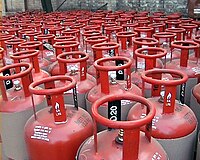
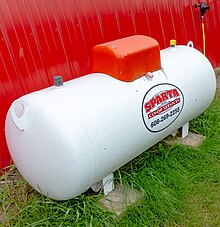
Predominantly in Europe and rural parts of many countries, LPG can provide an alternative toelectric heating,heating oil,orkerosene.LPG is most often used in areas that do not have direct access to pipednatural gas.In the UK about 200,000 households use LPG for heating.
LPG can be used as a power source forcombined heat and powertechnologies (CHP). CHP is the process of generating both electrical power and useful heat from a single fuel source. This technology has allowed LPG to be used not just as fuel for heating and cooking, but also for decentralized generation of electricity.
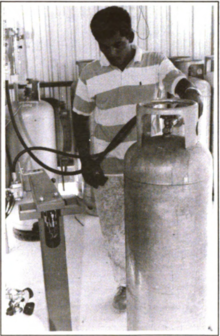
LPG can be stored in a variety of manners. LPG, as with otherfossil fuels,can be combined withrenewable power sourcesto provide greater reliability while still achieving some reduction in CO2emissions. However, as opposed towindandsolarrenewable energy sources, LPG can be used as a standalone energy source without the prohibitive expense of electricalenergy storage.In many climates renewable sources such as solar and wind power would still require the construction, installation and maintenance of reliable baseload power sources such as LPG fueled generation to provide electrical power during the entire year. 100% wind/solar is possible, the caveat being that the expense of the additional generation capacity necessary to charge batteries plus the cost of battery electrical storage makes this option economically feasible in only a minority of situations.[citation needed]
Motor fuel
[edit]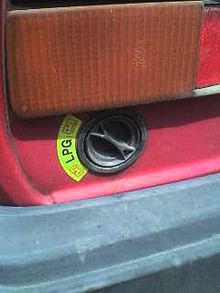
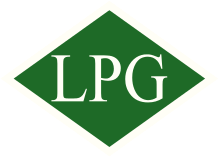
When LPG is used to fuelinternal combustion engines,it is often referred to asautogasor auto propane. In some countries, it has been used since the 1940s as a petrol alternative for spark ignition engines. In some countries, there are additives in the liquid that extend engine life and the ratio of butane to propane is kept quite precise in fuel LPG. Two recent studies have examined LPG-fuel-oil fuel mixes and found that smoke emissions and fuel consumption are reduced buthydrocarbonemissions are increased.[73][74]The studies were split on CO emissions, with one finding significant increases,[73]and the other finding slight increases at low engine load but a considerable decrease at high engine load.[74]Its advantage is that it is non-toxic, non-corrosive and free oftetraethylleador any additives, and has a highoctane rating(102–108RONdepending on local specifications). It burns more cleanly than petrol or fuel-oil and is especially free of theparticulatespresent in the latter.
LPG has a lower energy density per liter than either petrol or fuel-oil, so the equivalentfuel consumptionis higher. Many governments impose less tax on LPG than on petrol or fuel-oil, which helps offset the greater consumption of LPG than of petrol or fuel-oil. However, in many European countries, this tax break is often compensated by a much higher annual tax on cars using LPG than on cars using petrol or fuel-oil. Propane is the third most widely used motor fuel in the world. 2013 estimates are that over 24.9 million vehicles are fueled by propane gas worldwide. Over 25 million tonnes (over 9 billion US gallons) are used annually as a vehicle fuel.
Not all automobile engines are suitable for use with LPG as a fuel. LPG provides less upper cylinder lubrication than petrol or diesel, so LPG-fueled engines are more prone to valve wear if they are not suitably modified. Many modern common rail diesel engines respond well to LPG use as a supplementary fuel. This is where LPG is used as fuel as well as diesel. Systems are now available that integrate with OEM engine management systems.
Conversion kits can switch a vehicle dedicated to gasoline to using a dual system, in which both gasoline and LPG are used in the same vehicle.
In 2020, BW LPG successfully retrofitted a Very Large Gas Carrier (VLGC) with LPG propulsion technology, pioneering LPG's application in large-scale maritime operations.[75]LPG’s lowers emissions of carbon dioxide, sulfur oxides, nitrogen oxides, and particulate matter[76][77]align with stricter standards set by the International Maritime Organization (IMO), making LPG a viable transition option as the maritime industry transitions towards net zero carbon emissions.[78]
Conversion to gasoline
[edit]LPG can be converted intoalkylatewhich is a premiumgasolineblending stock because it has exceptional anti-knock properties and gives clean burning.
Refrigeration
[edit]LPG is instrumental in providingoff-the-gridrefrigeration, usually by means of agas absorption refrigerator.
Blended from pure, dry propane (refrigerant designatorR-290) andisobutane(R-600a) the blend "R-290a" has negligibleozone depletion potential,very lowglobal warming potentialand can serve as a functional replacement forR-12,R-22,R-134aand otherchlorofluorocarbonorhydrofluorocarbonrefrigerantsin conventional stationary refrigeration and air conditioning systems.[79]
Such substitution is widely prohibited or discouraged in motor vehicle air conditioning systems, on the grounds that usingflammablehydrocarbons in systems originally designed to carry non-flammable refrigerant presents a significant risk of fire or explosion.[80][81]
Vendors and advocates of hydrocarbon refrigerants argue against such bans on the grounds that there have been very few such incidents relative to the number of vehicle air conditioning systems filled with hydrocarbons.[82][83]One particular test, conducted by a professor at theUniversity of New South Wales,unintentionally tested the worst-case scenario of a sudden and complete refrigerant expulsion into the passenger compartment followed by subsequent ignition. He and several others in the car sustained minor burns to their face, ears, and hands, and several observers received lacerations from the burst glass of the front passenger window. No one was seriously injured.[84]
Propellant
[edit]Global production
[edit]Global LPG production reached over 292 million metric tons per year (Mt/a) in 2015, while global LPG consumption to over 284 Mt/a.[88]62% of LPG is extracted fromnatural gaswhile the rest is produced by petroleum refineries fromcrude oil.[89]44% of global consumption is in the domestic sector. The U.S. is the leading producer and exporter of LPG.[90]
Security of supply
[edit]Because of the natural gas and the oil-refining industry, Europe is almost self-sufficient in LPG. Europe's security of supply is further safeguarded by:
- a wide range of sources, both inside and outside Europe;
- a flexible supply chain via water, rail and road with numerous routes and entry points into Europe.
According to 2010–12 estimates,proven world reserves of natural gas,from which most LPG is derived, stand at 300 trillion cubic meters (10,600 trillion cubic feet). Production continues to grow at an average annual rate of 2.2%.
Comparison with natural gas
[edit]LPG is composed mainly of propane and butane, while natural gas is composed of the lightermethaneandethane.LPG, vaporised and at atmospheric pressure, has a highercalorific value(46 MJ/m3equivalent to 12.8 kWh/m3) thannatural gas(methane) (38 MJ/m3equivalent to 10.6 kWh/m3), which means that LPG cannot simply be substituted for natural gas. In order to allow the use of the same burner controls and to provide for similar combustion characteristics, LPG can be mixed with air to produce a synthetic natural gas (SNG) that can be easily substituted. LPG/air mi xing ratios average 60/40, though this is widely variable based on the gases making up the LPG. The method for determining the mi xing ratios is by calculating theWobbe indexof the mix. Gases having the same Wobbe index are held to be interchangeable.
LPG-based SNG is used in emergency backup systems for many public, industrial and military installations, and many utilities use LPGpeak shavingplants in times of high demand to make up shortages in natural gas supplied to their distributions systems. LPG-SNG installations are also used during initial gas system introductions when the distribution infrastructure is in place before gas supplies can be connected. Developing markets in India and China (among others) use LPG-SNG systems to build up customer bases prior to expanding existing natural gas systems.
LPG-based SNG or natural gas with localized storage and piping distribution network to the households for catering to each cluster of 5000 domestic consumers can be planned under the initial phase of the city gas network system. This would eliminate the last mile LPG cylinders road transport which is a cause of traffic and safety hurdles in Indian cities. These localized natural gas networks are successfully operating in Japan with feasibility to get connected to wider networks in both villages and cities.
Environmental effects
[edit]Commercially available LPG is currently derived mainly from fossil fuels. Burning LPG releasescarbon dioxide,agreenhouse gas.The reaction also produces somecarbon monoxide.LPG does, however, release lessCO
2per unit of energy than does coal or oil, but more than natural gas. It emits 81% of theCO
2perkWhproduced by oil, 70% of that of coal, and less than 50% of that emitted by coal-generated electricity distributed via the grid.[91]Being a mix of propane and butane, LPG emits less carbon perjoulethan butane but more carbon per joule than propane.
LPG burns more cleanly than higher molecular weighthydrocarbonsbecause it releases lessparticulate matter.[92]
As it is much less polluting than most traditional solid-fuel stoves, replacing cookstoves used in developing countries with LPG is one of the key strategies adopted to reducehousehold air pollutionin the developing world.[93]
Fire/explosion risk and mitigation
[edit]This sectionneeds additional citations forverification.(September 2009) |
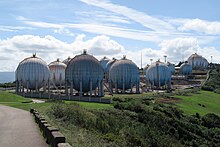
In a refinery or gas plant, LPG must be stored inpressure vessels.These containers are either cylindrical and horizontal (sometimes referred to as bullet tanks) or spherical (of theHorton spheretype). Typically, these vessels are designed and manufactured according to some code. In the United States, this code is governed by theAmerican Society of Mechanical Engineers(ASME).
LPG containers have pressure relief valves, such that when subjected to exterior heating sources, they will vent LPGs to the atmosphere or aflare stack.
If a tank is subjected to a fire of sufficient duration and intensity, it can undergo aboiling liquid expanding vapor explosion(BLEVE). This is typically a concern for large refineries and petrochemical plants that maintain very large containers. In general, tanks are designed so that the product will vent faster than pressure can build to dangerous levels.
One remedy that is utilized in industrial settings is to equip such containers with a measure to provide afire-resistance rating.Large, spherical LPG containers may have up to a 15 cm steel wall thickness. They are equipped with an approved pressure reliefvalve.A large fire in the vicinity of the vessel will increase its temperature andpressure.The relief valve on the top is designed to vent off excess pressure in order to prevent the rupture of the container itself. Given a fire of sufficient duration and intensity, the pressure being generated by the boiling and expanding gas can exceed the ability of the valve to vent the excess. Alternatively, if, due to continued venting, the liquid level drops below the area being heated, the tank structure can be overheated and subsequently weakened in that area. If either occurs, the container may rupture violently, launching pieces of the vessel at high velocity, while the released products can ignite as well, potentially causing catastrophic damage to anything nearby, including other containers.
People can be exposed to LPG in the workplace by breathing it in, skin contact, and eye contact. TheOccupational Safety and Health Administration(OSHA) has set the legal limit (Permissible exposure limit) for LPG exposure in the workplace as 1000 ppm (1800 mg/m3) over an 8-hour workday. TheNational Institute for Occupational Safety and Health(NIOSH) has set arecommended exposure limit(REL) of 1000 ppm (1800 mg/m3) over an 8-hour workday. At levels of 2000 ppm, 10% of the lower explosive limit, LPG is consideredimmediately dangerous to life and health(due solely to safety considerations pertaining to risk of explosion).[94]
See also
[edit]- Compressed natural gas(CNG)
- Filling carousel
- Gasoline gallon equivalent
- Industrial gas
- Intumescent
- POL valve
References
[edit]- ^World Energy Prices: Database Documentation(PDF)(Report) (2020 ed.).International Energy Agency.Archived(PDF)from the original on 8 February 2024.Retrieved8 February2024.
- ^NFPA(2017).Liquefied Petroleum Gas Code.NFPA 58 (2017 ed.). Quincy, Mass.:National Fire Protection Association.pp. 11, 132.ISBN978-1455913879.
- ^Enciclopedia degli idrocarburi[Encyclopaedia of Hydrocarbons] (in Italian). Vol. II. Roma, Italy:EniandIstituto della Enciclopedia Italiana.2005. p. 26.OCLC955421604.
- ^Alvi, Moin ud-Din."Aerosol Propellant | Aerosol Propellant Gas | Aerosol Supplies Dubai – Brothers Gas".brothersgas.Archivedfrom the original on 30 December 2016.Retrieved14 June2016.
- ^"Performance and Safety of LPG Refrigerants"(PDF).Archived fromthe original(PDF)on 10 March 2015.
- ^ed, George E. Totten, ed. (2003).Fuels and lubricants handbook: technology, properties, performance, and testing(2nd printing. ed.). West Conshohocken, Pa.: ASTM International.ISBN9780803120969.Archivedfrom the original on 4 June 2016.
- ^Unipetrol."Analysis of seasonal mixtures – Propane-butane Fuel Mixture (Summer, Winter)".Archived fromthe originalon 9 August 2010.Retrieved29 April2013.
- ^"Liquefied Petroleum Gas Specifications and Test Methods".Gas Processors Association.Archivedfrom the original on 21 June 2013.Retrieved18 May2012.
- ^"ASTM D1835 – 11 Standard Specification for Liquefied Petroleum (LP) Gases".American Society for Testing & Materials.Archivedfrom the original on 22 May 2012.
- ^49 CFR173.315
- ^Horst Bauer, ed. (1996).Automotive Handbook(4th ed.). Stuttgart:Robert Bosch GmbH.pp. 238–239.ISBN0-8376-0333-1.
- ^Zivenko, Oleksiy (2019)."LPG Accounting Specificity During ITS Storage and Transportation".Measuring Equipment and Metrology.80(3): 21–27.doi:10.23939/istcmtm2019.03.021.ISSN0368-6418.S2CID211776025.
- ^"High-purity propylene from refinery LPG".
- ^Kinetic studies of propane oxidation on Mo and V based mixed oxide catalysts.2011.
- ^"LPG pdf"(PDF).
- ^"Algeria Lpg Prices".
- ^"Angola Lpg Prices".
- ^"Saudi Arabia Lpg Prices".
- ^"Russia Lpg Prices".
- ^"Kyrgyzstan Lpg Prices".
- ^"Azerbaijan Lpg Prices".
- ^"Taiwan Lpg Prices".
- ^"Australia Lpg Prices".
- ^"Honduras Lpg Prices".
- ^"Peru Lpg Prices".
- ^"Belarus Lpg Prices".
- ^"Cambodia Lpg Prices".
- ^"Paraguay Lpg Prices".
- ^"Lithuania Lpg Prices".
- ^"Bulgaria Lpg Prices".
- ^"Turkey Lpg Prices".
- ^"Ukraine Lpg Prices".
- ^"Mongolia Lpg Prices".
- ^"Georgia Lpg Prices".
- ^"Albania Lpg Prices".
- ^"South Korea Lpg Prices".
- ^"Dominican Republic Lpg Prices".
- ^"Poland Lpg Prices".
- ^"Chile Lpg Prices".
- ^"Philippines Lpg Prices".
- ^"Estonia Lpg Prices".
- ^"Czech Republic Lpg Prices".
- ^"Bosnia And Herzegovina Lpg Prices".
- ^"India Lpg Prices".
- ^"Slovakia Lpg Prices".
- ^"San Marino Lpg Prices".
- ^"Latvia Lpg Prices".
- ^"Romania Lpg Prices".
- ^"Italy Lpg Prices".
- ^"Macedonia Lpg Prices".
- ^"Moldova Lpg Prices".
- ^"Belgium Lpg Prices".
- ^"Luxembourg Lpg Prices".
- ^"Netherlands Lpg Prices".
- ^"Lebanon Lpg Prices".
- ^"Serbia Lpg Prices".
- ^"Portugal Lpg Prices".
- ^"United Kingdom Lpg Prices".
- ^"Canada Lpg Prices".
- ^"Slovenia Lpg Prices".
- ^"Croatia Lpg Prices".
- ^"Israel Lpg Prices".
- ^"Hungary Lpg Prices".
- ^"Spain Lpg Prices".
- ^"France Lpg Prices".
- ^"Greece Lpg Prices".
- ^"Fiji Lpg Prices".
- ^"Switzerland Lpg Prices".
- ^"Germany Lpg Prices".
- ^"Sweden Lpg Prices".
- ^"LPG Profile"(PDF).Archived(PDF)from the original on 8 April 2017.Retrieved30 March2017.
- ^"ANP quer fim de diferença entre preços do gás de botijão – 17/08/2017 – Mercado".Folha de S.Paulo.Retrieved25 January2019.
- ^abZhang, Chunhua; Bian, Yaozhang; Si, Lizeng; Liao, Junzhi; Odbileg, N (2005). "A study on an electronically controlled liquefied petroleum gas-diesel dual-fuel automobile".Proceedings of the Institution of Mechanical Engineers, Part D: Journal of Automobile Engineering.219(2): 207.doi:10.1243/095440705X6470.S2CID109657186.
- ^abQi, D; Bian, Y; Ma, Z; Zhang, C; Liu, S (2007). "Combustion and exhaust emikon characteristics of a compression ignition engine using liquefied petroleum gas–fuel-oil blended fuel".Energy Conversion and Management.48(2): 500.doi:10.1016/j.enconman.2006.06.013.
- ^"World's first VLGC to be retrofitted with pioneering LPG propulsion technology achieves historic milestone; successfully runs on LPG fuel".BW Group.21 October 2020.Retrieved21 February2024.
- ^"Benefits of LPG Propulsion".BW LPG.Retrieved21 February2024.
- ^"Liquefied Petroleum Gas (LPG) - What is it?".BW LPG.1 May 2024.Retrieved13 May2024.
- ^"Net-zero by 2050: Achieving shipping decarbonization through industry momentum and the new ambition at IMO | UNCTAD".unctad.org.22 September 2023.Retrieved21 February2024.
- ^"*overview of advantages and disadvantages of alternatives*"(PDF).Technical Meeting on HCFC Phase-Out.European Commission. 5–6 April 2008. Archived fromthe original(PDF)on 5 August 2009.Retrieved30 July2009.
- ^"Detailed Questions About HC-12a ®, OZ-12 ®, DURACOOL 12a ®, EC-12a, and other Flammable Hydrocarbon Refrigerants".Ozone Layer Depletion - Alternatives / SNAP.United States Environmental Protection Agency.Archived fromthe originalon 7 August 2009.Retrieved30 July2009.
- ^"A Warm Weather Warning: Stay Away from Flammable Hydrocarbon Refrigerants".Society of Automotive Engineers.27 April 2005. Archived fromthe originalon 5 May 2005.Retrieved30 July2009.
- ^Iemma, Morris; Lo Po', Faye (16 October 1997)."Motor Vehicle Hydrocarbons".Parliament of New South Wales. Archived fromthe originalon 1 July 2009.Retrieved30 July2009.
- ^Ryan, J. F. (29 June 2000)."Hydrocarbon Refrigerants".Parliament of New South Wales. Archived fromthe originalon 22 May 2005.Retrieved30 July2009.
- ^"Car explosion leads to prosecution against leading hydrocarbon promoter"(PDF).VASA.7 April 2005. Archived fromthe original(PDF)on 19 July 2008.Retrieved24 May2012.
- ^"Fires Halted Quickly by" Lazy "Freon Gas".Popular Mechanics.Vol. 87.Hearst Magazines.April 1947. p. 115.Retrieved7 June2019.
Freon chemical compounds in household refrigerators, air-cooling systems and as aDDTcarrier in aerosolinsect bombshave been found to be more effective in extinguishing fires than carbon dioxide.
- ^Yeoman, Amber M.; Lewis, Alastair C. (22 April 2021)."Global emissions of VOCs from compressed aerosol products".Elementa: Science of the Anthropocene.9(1): 00177.doi:10.1525/elementa.2020.20.00177.ISSN2325-1026.
- ^"Solstice® Propellant Technical Bulletin"(PDF).Honeywell.2017.
- ^"Statistical Review of Global LPG 2016"(PDF).Argus Media.Archived fromthe original(PDF)on 10 April 2017.Retrieved13 January2017.
- ^"WLPGA Annual Report 2015"(PDF).World LPG Association.Archived(PDF)from the original on 10 April 2017.Retrieved13 January2017.
- ^Needham, John (7 April 2016)."U.S. Is World's Largest LPG Exporter, But When Will Market Balance?".Butane Propane News.Archivedfrom the original on 30 December 2017.Retrieved10 April2017.
- ^Green Finance and Investment Promoting Clean Urban Public Transportation and Green Investment in Kazakhstan.OECD Publishing. 2017. p. 124.ISBN978-9264279643.
- ^Shah, Yatish T. (16 March 2017).Chemical Energy from Natural and Synthetic Gas.CRC Press.ISBN9781315302348.
- ^World Health Organization (2016).Burning opportunity: clean household energy for health, sustainable development, and wellbeing of women and children.Geneva, Switzerland:WHO.Archived fromthe originalon 24 November 2017.
- ^"CDC – NIOSH Pocket Guide to Chemical Hazards – L.P.G."cdc.gov.Archivedfrom the original on 8 December 2015.Retrieved28 November2015.
"Calorific value of Different Fuels".Centre for Ecological Sciences.IISc. Archived fromthe originalon 19 February 2020.

